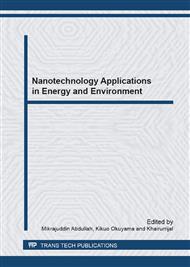[1]
N.R. Frómeta, Cantilever biosensors, Biotecnología Aplicada 23 (2006) 320-323.
Google Scholar
[2]
N.V. Larvik, M.J. Sepaniak, P.G. Datskos, Cantilever transducers as a platform for chemical and biological sensors, Rev. Sci. Instrum. 75 (2004) 2229–2250.
DOI: 10.1063/1.1763252
Google Scholar
[3]
C. Wang, D. Wang, Y. Mao, X. Hu, Ultrasensitive biochemical sensors based on microcantilevers of atomic force microscope, Anal. Biochem. 363 (2007) 1-11.
DOI: 10.1016/j.ab.2006.12.010
Google Scholar
[4]
O. Wolter, T. Bayer, J. Greschner, Micromachined silicon sensors for scanning force microscopy, J. Vac. Sci. Technol. B. 9 (1990) 1353-1357.
Google Scholar
[5]
H.P. Lang, M. Hegner, C. Gerber, Nanomechanical cantilever array sensors, in: B. Bhushan (Eds. ), Springer Handbook of Nanotechnology, 2nd ed, Berlin, 2007, pp.443-460.
DOI: 10.1007/978-3-540-29857-1_16
Google Scholar
[6]
S. Hosaka, T. Chiyoma, A. Ikeuchi, H. Okano, H. Sone, T. Izumi, Possibility of a femtogram mass biosensor using a self-sensing cantilever, Current Appl. Phys. 6 (2006) 384-388.
DOI: 10.1016/j.cap.2005.11.024
Google Scholar
[7]
H. Sone, A. Ikeuchi, T. Izumi, H. Haruki, S. Hosaka, Femtogram mass biosensor using self-sensing santilever for allergy check, Japanese J. Appl. Phys. 45 (3B) (2006) 2301-2304.
DOI: 10.1143/jjap.45.2301
Google Scholar
[8]
E. Finot, A. Passian, T. Thundat, Measurement of mechanical properties of cantilever shaped materials, Sensors 8 (2008) 3497-3541.
DOI: 10.3390/s8053497
Google Scholar
[9]
S.K. Vashist, A review of microcantilevers for sensing applications, Ozojono Journal of Nanotechnology Online (2007) 1-15.
Google Scholar
[10]
F. Lochon, I. Dufour, D. Rebi`ere, An alternative solution to improve sensitivity of resonant microcantilever chemical sensors: comparison between using high-order modes and reducing dimensions, Sensors and Actuators B 108 (2005) 979–998.
DOI: 10.1016/j.snb.2004.11.086
Google Scholar
[11]
S. Dohn, R. Sandberg, W. Svendsen, A. Boisen, Enhanced functionality of cantilever based mass sensors using higher modes and functionalized particles, Digest Techn. Proceedings of the Transducers '05 Conference Korea, 2005, pp.636-639.
DOI: 10.1109/sensor.2005.1496497
Google Scholar
[12]
D. Jin, X. Li, J. Liu, G. Zuo, Y. Wang, M. Liu, H. Yu, High-mode resonant piezoresistive cantilever sensors for tens-femtogram resoluble mass sensing in air, J. Micromech. Microeng. 16 (2006) 1017-1023.
DOI: 10.1088/0960-1317/16/5/019
Google Scholar
[13]
M. Narducci, E. Figueras, I. Gràcia, L. Fonseca, J. Santander, C. Cané, Modeling of T-shaped microcantilever resonators, Dans Symposium on Design, Test, Integration and Packaging of MEMS/MOEMS – DTIP, Italy, (2007).
Google Scholar
[14]
J.E. Sader, Parallel beam approximation for V-shaped atomic force microscope cantilevers, Rev. Sci. In-strum. 66 (9) (1995) 4583-4587.
DOI: 10.1063/1.1145292
Google Scholar


